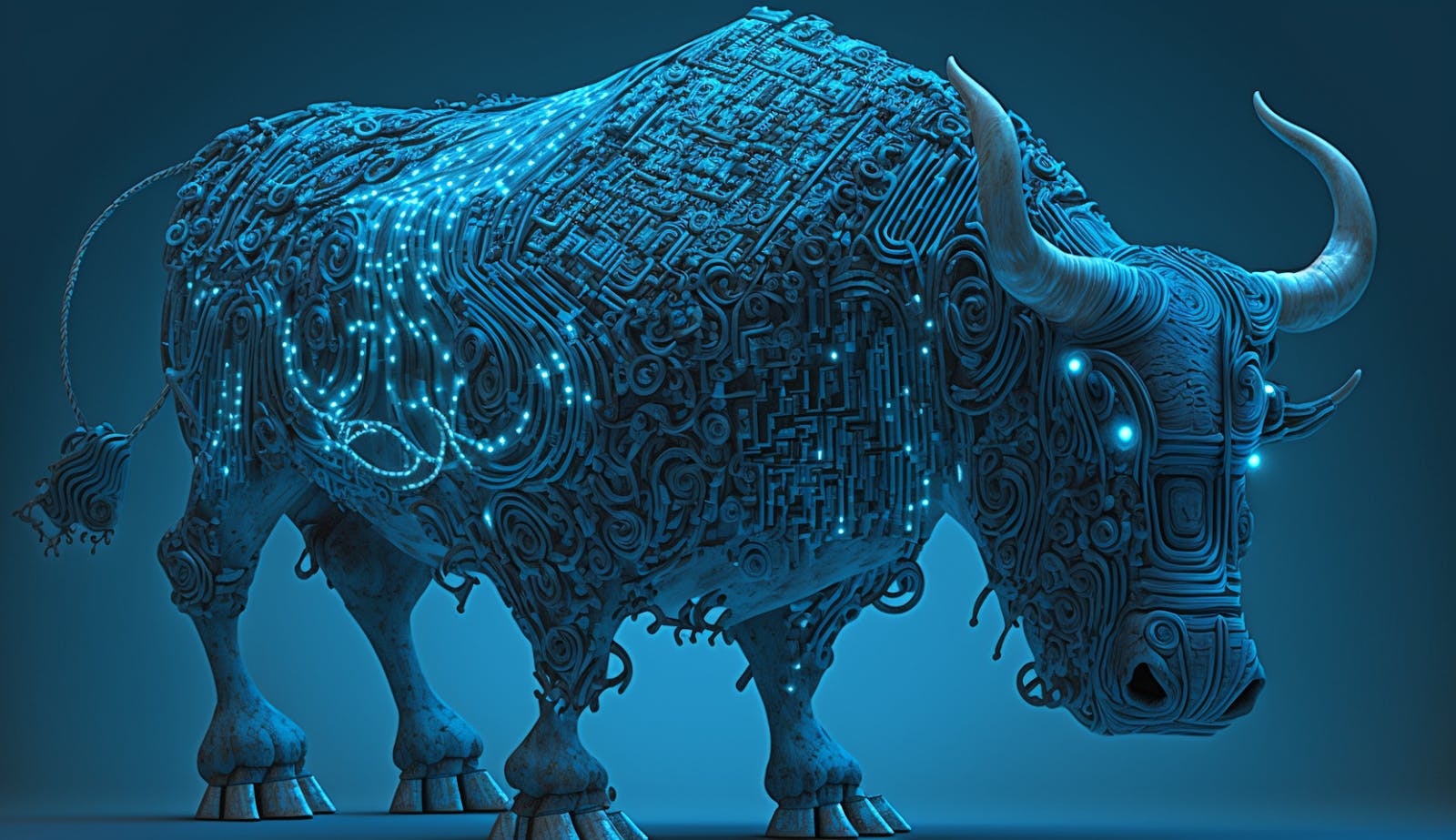The Minotaur Myth
The Minotaur from Greek mythology is a perfect example of something that had tremendous power yet also had a fatal weakness. The Minotaur was a half-human, half-bull creature with great strength and ferocity.
However, it was ultimately defeated by the Athenian hero Theseus, who used the creature’s one fatal weakness—its inability to navigate the labyrinth in which it was imprisoned—against it.
Now, let’s find out how this powerful Greek mythical creature has anything to do with modern-day Microsoft, and how can aspiring young entrepreneurs find ways to fight its almost insurmountable power.
Microsoft’s Resurgence

Microsoft’s resurgence
When Satya Nadella took the reins as Microsoft’s CEO in 2014, he inherited a company that was facing stagnation and struggling to compete in the rapidly evolving technology landscape.
Nadella’s leadership has since been credited with reinvigorating Microsoft by pivoting its focus from traditional operating systems and productivity software to cloud computing and AI.
One good example is the Office productivity suite, and how it has evolved both before and after Nadella’s reign.
Microsoft Office, first introduced in 1989, has become a cornerstone of productivity and communication in the business world.
As a suite of software applications, it initially comprised Word, Excel, and PowerPoint, but has since grown to include other tools such as Outlook, Access, and Publisher.
Microsoft’s consistent efforts to improve and refine these applications have allowed them to maintain a dominant position in the market.
By the early 2000s, Microsoft Office had become the industry standard for document creation, data management, and presentation design, a position it continues to hold today.
In 2011, Microsoft introduced Office 365, a significant shift in the company’s business strategy. By transitioning to a cloud-based, subscription model. This model helped solidify Microsoft’s dominance in the market, while also creating a strong customer lock-in effect.
The subscription model ensured a steady revenue stream for Microsoft and encouraged users to stay within the ecosystem, as the cost of switching to alternative solutions became more cumbersome and less appealing.
But Microsoft’s ambitions went far beyond Office 365 and Azure cloud computing.
Enter the Minotaur
As we recall from the Greek myth, the Minotaur had great strength, mostly because it was a hybrid creature of half human and half bull. If we might make an analogy, Microsoft is:
- Half Human: human language and wisdom via OpenAI exclusive license
- Half Bull: computer language and intelligence via its ownership of GitHub
We shall delve into each of these equally powerful halves for deeper analysis.
Half Human – OpenAI and ChatGPT

OpenAI and human intelligence
Microsoft’s strategic investment in and its exclusive licensing partnership with OpenAI, the inventor of ChatGPT, has played a significant role in solidifying the company’s position as a dominant player in the AI field.
Announced in 2019, the partnership has helped Microsoft leverage OpenAI’s cutting-edge research to develop new AI technologies and integrate them into its products and services.
This collaboration has fueled the growth of Microsoft’s AI ecosystem, enabling the company to deliver AI-driven capabilities across its offerings, including Azure AI services, Cortana, and even Office 365 applications.
The sheer scope and unusually high velocity of OpenAI integration inside Office 365, Microsoft’s crown jewel of productivity suite, speaks volumes of the strategic importance of OpenAI to Microsoft.
So, in a way, Microsoft now captures the entirety of human language, knowledge, and at least some inferred wisdom (which some Microsoft researchers called “a spark of AGI”). Through its exclusive licensing deal with OpenAI, it won’t have any close competitors.
You may argue that Google and Meta might challenge OpenAI/Microsoft’s monopoly, but their respective large language models, Bard and LLaMA, appear to be at least one generation behind.
In addition, OpenAI has evolved from a non-profit organization to a capped-profit organization. And there is this amusing cap of profit at 100 times investment.
Since Microsoft has already pumped and planned to pump over 10 billion dollars into OpenAI, you can safely assume that OpenAI will not disassociate from Microsoft any time soon.
And Microsoft can always “invest” more money into OpenAI instead of buying products and services from OpenAI. This will perpetuate the symbiosis between OpenAI and Microsoft.
It is no surprise that a bunch of very important people are alarmed enough to sign a petition to halt all AI research for the next 6 months.
Half Bull – GitHub, Codex, and Co-Pilot

GitHub and digital bull
The acquisition and integration of GitHub in 2018, a leading platform for software development and collaboration, further extended Microsoft’s grip on human intelligence as a whole.
GitHub is a hub for all leading open-source projects, and you can consider it the aggregated repository of human intelligence expressed in a computer language that runs everything for everyone in today’s world.
I would like to highlight the significance of OpenAI’s Codex, an advanced language model that has had a profound impact on the field of software development, particularly through its integration with GitHub’s Copilot.
Codex, which is part of the GPT-3 family of models, is capable of understanding and generating human-like text, including programming code.
Its ability to interpret natural language queries and generate accurate and contextually relevant code snippets has made it a valuable tool for developers.
GitHub’s Copilot, which leverages the capabilities of Codex, serves as an AI-powered coding assistant that helps developers write code more efficiently by providing real-time suggestions and automatically completing code segments.
Copilot’s integration with Codex has transformed the software development process by reducing the time and effort required to write code, minimizing errors, and enabling developers to focus on higher-level design and problem-solving tasks.
After using GitHub Co-Pilot for an extended period of time and recently combining it with ChatGPT v4, I have just started to realize its tremendous power and immense potential.
As a product manager and co-founder, now I can conceptualize an idea, write a succinct requirement, and let ChatGPT spit out a pretty decent boilerplate.
Then, in Visual Studio Code with GitHub Co-Pilot, I can modify the function and parameters where necessary, fine-tune a bit of control flow and business logic, and I have a fully working prototype within hours.
Since I’m not a real practicing software engineer, such prototyping would have cost me 1-2 weeks of hacking time or begging some software engineers to work on it.
And it is not that far off from a true “no code” software development movement that will flourish among people who don’t even understand the basics of existing computer programming languages.
For experienced software engineers, there are claims of 3x or even 10x productivity improvements via the combination of GitHub Co-Pilot and chatGPT v4.
These tools can easily find the design patterns from GitHub’s gigantic repository and fit into the context of the software system that the developer is currently working on.
It saves a lot of Google searches, reduces typing and error checking, and automates a large portion of documentation and testing. One engineer even lamented that he felt like losing one of his arms when GitHub Co-Pilot was offline for a few hours.
The Potential Danger of the Minotaur
Google’s mission is to “organize the world’s information and make it universally accessible and useful”, and it achieves that by basically doing a PageRank on all the websites and building a giant index for them.
But with Microsoft/OpenAI’s GPT large language model and GitHub codex, the world’s information might become condensed into billions and trillions of weights (numbers of statistical importance, figuratively speaking).
And that’s when it hit me that we have entered the Minotaur moment of Microsoft.
Microsoft’s deep-rooted relationship with OpenAI has raised concerns about the potential for the company to use its combined power to create a monopoly in the field of artificial intelligence.
OpenAI’s GPT-4 language model is one of the most powerful AI systems in the world today, and GitHub is the world’s largest code-hosting platform.
If Microsoft were to use these tools to stifle competition, it could have a significant impact on the development of AI and the tech industry as a whole.
It is important to note that these are just concerns, and there is no evidence that Microsoft is planning to use its combined power in a monopolistic way.
However, it is crucial to be aware of the potential dangers of such a move and to ensure that Microsoft does not abuse its power.
The Hope for Theseus (and Startups)

Young Theseus
Innovate on the Shoulders of Giants
Startups can leverage big companies’ platforms to innovate on new products by tapping into the resources, infrastructure, and user base that these platforms offer. Here are a few examples of previous success stories:
- Apple App Store and Google Play Store: By building apps on these platforms, startups can access a vast market of smartphone users, easily distribute their products, and benefit from the app stores’ secure payment systems.
- Amazon Web Services (AWS): Startups can utilize AWS’s cloud computing infrastructure to build and scale their applications, store data, and access advanced analytics tools. This allows them to focus on innovation and product development without worrying about investing in and managing their own IT infrastructure.
By leveraging big companies’ platforms, startups can gain access to resources, infrastructure, and user bases that would otherwise be difficult or expensive to acquire. This enables them to focus on innovation and product development, increasing the chances of success in the competitive market.
We are already witnessing the Cambrian Explosion for AI-powered tools and solutions. Not a single day goes by without a flurry of announcements from aspiring startups mashing up OpenAI’s GPT with new datasets (legal, financial), other AI models (voice recognition, image recognition), other generative AI solutions (voice synthesizing, text-to-image and text to video), and many more.
Seek Help From the Sovereign
One of the key risks of building on 3rd party for-profit platforms is that the platform might change, die, or even compete against its own ecosystem partners. One example is Facebook vs Zynga, while another example is major social networks’ de-platforming of different ideologies.
Therefore, entrepreneurs might be able to find help in unusual places: Governments and Regulators to thwart any anti-competitive behavior. And they might be able to learn a page from the previous anti-trust lawsuits in the technology sector.
Playing the Game in the Open

Open field
Open source has been the trusted and true weapon to fight big closed-source monoliths. Since OpenAI has closed-source its GPT-3 and GPT-4 models, Meta did an atypical move and open-sourced its own large language model named LLaMA for research purposes.
This is by far the most advanced open-source LLM, with up to 65 billion weights trained on 1.4 trillion words.
Even more interestingly, Meta also open-sourced 7, 13, and 33 billion weight models. These smaller LLMs enabled many research teams to come up with their own fine-tuned models based on the LLaMA.
To name just a few: Alpaca from Stanford, Vicuna and Koala from Berkeley, GPT4All, and many many more.
Using Reinforced Learning via Human Feedback, these research efforts claim they can reach 90-95% performance of the commercial ChatGPT 3.5 (175 billion weights), with only 7 billion or 13 billion weights.
When you have these smaller LLM models and optimized C++ implementations like llama.cpp, suddenly you can run these models locally on your laptop. You now have a smart assistant running locally that does not rely on cloud service and costs nothing.
The LLaMA models are for research only, thus you cannot use them commercially.
There does truly exist open source LLMs, even though their scale and performance are generations behind the state of art commercial alternatives. However, many more open-source LLMs are popping up like mushrooms after an autumn rain.
If you keep alert on huggingface and GitHub, you can find many of them such as:
- OpenAI: GPT-2 and GPT-Neo
- Together.xyz OpenChatKit
- Nomic-ai GPT4All
Think Outside of the Labyrinth

The labyrinth
Office 365 might be Microsoft’s own Labyrinth. Why would I say that?
Above all, Office 365 is critically important to Microsoft from a revenue and profit point of view (23% of total revenue in 2022 (source). Microsoft might be able to add OpenAI capabilities to Office 365, but it might remain to be an incremental update rather than a fundamental change.
This is simply because Microsoft cannot move their enterprise customers, who are known to be risk-averse and glacial in change, into a new paradigm at too fast a pace or too dramatic a way. So in a way, Office 365 is kind of Microsoft’s shackles as well.
So where are the opportunities for young startups? If we step back a bit, the reason we created the Microsoft Office suite, including Word, Powerpoint, and Excel, was that we could communicate better in a business environment.
How can we invent new ways of communication that transcend beyond these existing tools? Think how Slack and Notion have transcended from emails, and how Figma has surpassed the traditional Adobe creative suite.
Imagine how newer human-machine and human-human interfaces can work in a business environment.
If you want to push into sci-fi territories, you can take into account Elon Musk’s Neuralink where humans and machines are electrically connected.
The advent of technologies like Elon Musk’s Neuralink, which aims to establish direct communication between human brains and machines, opens up exciting possibilities for reimagining communication in the business environment.
Here are a few ways such technology could potentially transcend traditional tools like the Microsoft Office suite:
- Thought-to-text communication: With the help of brain-computer interfaces (BCIs) like Neuralink, people could communicate their thoughts directly as text or visual content, bypassing the need for keyboards or other input devices. This could lead to a more efficient and faster exchange of ideas, minimizing misunderstandings and miscommunications that can arise from conventional methods.
- Collaborative brainstorming: Brain-computer interfaces could enable real-time sharing of thoughts and ideas during brainstorming sessions, allowing team members to simultaneously contribute and visualize concepts. This could enhance creative problem-solving and decision-making processes, fostering a more collaborative and efficient work environment.
- Immersive presentations: Combining BCIs with augmented reality (AR) or virtual reality (VR) technologies could revolutionize business presentations. Instead of relying on traditional tools like PowerPoint, presenters could create immersive, interactive experiences that engage the audience’s senses and emotions, leading to more effective communication of complex concepts and ideas.
- Emotion-aware communication: BCIs could potentially detect emotions and mental states during conversations, enabling participants to better understand each other’s feelings and perspectives. This could enhance empathy, facilitate constructive feedback, and foster healthier working relationships.
- Direct knowledge transfer: Neuralink and similar technologies could pave the way for direct knowledge transfer between individuals or from machines to humans. This could revolutionize learning and training processes in the workplace, making them more efficient and personalized.
While the development and implementation of technologies like Neuralink still have a long way to go, their potential to transform communication in the business environment is undeniable.
By enabling more direct, efficient, and empathetic forms of communication, brain-computer interfaces could revolutionize how we collaborate, make decisions, and share knowledge in the workplace.
An Uncertain Future

Look out into future
While I am excited and elated by the newfound productivity gain from Microsoft’s OpenAI and GitHub combination, I am also concerned that one company can hold that much power over the entirety of the human race’s collective intelligence.
I hope young Theseus can pick up the open-source sword and fight a new path outside of the labyrinth so that humanity’s intellect can prosper freely.
Footnote: all illustrations are by the author and MidJourney
This article was originally published by Bruce Li on Hackernoon.











